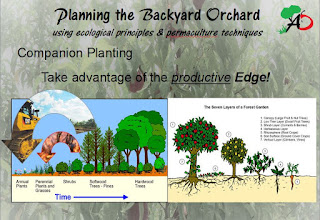I really enjoyed preparing and sharing the Backyard Orchard class this weekend!
If you missed it, it will be one I would love to do again. Watch for it again next year for sure!
One of the points covered was occupying all the available growing space with desirable plants. We can also use that principle as we plan our annual vegetable gardens using Intensive Methods.
 |
| Three Sisters - Corn, beans & squash Intensively planted |
There are several variations to intensive gardening, such as John Jeavons' Grow BioIntesive method or Mel Bartholemew's Square Foot Gardening. One thing they all have in common is higher planting densities.
Benefits are many with high density planting
One of the benefits of closer planting is less space needed for production. This is important for gardeners in urban areas with less overall space, or those that want to keep more space for entertaining or the traditional lawn.
You an also reduce the amount of water because the growing leaves cover the soil faster so there is less bare ground for the sun to hit. The canopy cools the soil and then holds in more moisture that would burn off or be blown away in the breeze.
 |
| Green beans planted in a grid using the in row spacing |
Weeding time is also reduced. My wife is often asked why I don't spend a lot of time weeding our garden. If you are vigilant at first, the closely growing garden plants will shade out the later weeds better. If a weed does sneak through it will be weaker and spindly from the lack of sunshine, and quickly snipped off or pulled when noticed.
Seed costs are also reduced, as thinning won't be required. More on that later.
Several practices will help you grow intensively.
In our gardens we have dedicated walkways and beds for growing. This eliminates the need for rows. Rows use up a lot of space to give access for thinning and weeding. The between row space is still watered, and generally fertilized, gets compacted, and leaves the soil exposed to sun and wind.
Our beds are kept narrow enough (3-4') so that I can reach the centers without ever having to step in the growing area. I've used new cedar 2x's as well as upcycled decking and siding to designate the borders. Cedar lasts a long time and is not treated with anything that could leach into the soil.
Without my big boots clomping around, compaction and the need for tilling is reduced. I actually have not tilled my beds other than digging potatoes and loosening the ground for carrots since the beds were established. Instead I rely on the actions of earthworms and plant roots to keep the soil loose.

Composting also helps to grow intensively. With higher production, we put a higher demand on the soil. Nutrients that we pull out of the soil in the form of grain, vegetables and fruit need to be replaced. Compost also feeds and boosts soil life that helps cycle nutrients through the soil food web making them more available for growing plants.
Worm castings are a high grade soil amendment!
Get some for your garden from our friends at Browne Atlas
For planting use the in row, after thinning distance across the beds. Instead of placing seeds in separate rows, plant them in a grid pattern throughout your beds. With dedicated walkways, you no longer need rows to walk down. And without thinning, you no longer use seed that will be cut anyway, saving seed costs as mentioned above.
How to get even higher productivity in small spaces
-Using trellis to capture the third dimension for vining plants like cucumbers and squash
Also, think runner beans vs bush beans
-Keyhole beds can reduce your pathway footprint even further
-Combine crops into companion plantings, like the Three Sisters guild above
Increase spacing more, lowers individual crop yield/area but greater overall yields
I hope these tips boost the yields in your garden this coming season!
And if don't have a garden but want one, give us a call and we'll get one built for you.
Think it's too much work for your busy lifestyle? We can help with that too; check it out on our Stewardship page!







No comments:
Post a Comment